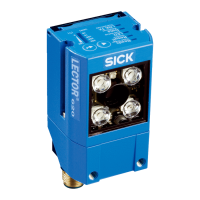ONLINE HELP SOPAS Chapter 5
LECTOR®620
Parameters
8013778/Y269/2013-11-27 © SICK AG · Germany · All rights reserved · Subject to change without notice 111
5.8.8.3.1 Rx header
The Rx header parameter is used to define a header for the received data. This header is
used by the sensor to identify the start of the input data. The identification must differ from
the SOPAS command. It is recommended to use the default setting.
The header is restricted to two characters and must be entered via the context menu or the
button. It is possible to enter control characters and constants. The input field is high-
lighted in red if invalid characters are entered.
5.8.8.3.2 Rx terminator
The Rx terminator parameter is used to define a terminator for the received data. This ter-
minator is used by the sensor to identify the end of the input data.
The input is restricted to two characters and must be entered via the context menu or the
button. It is possible to enter control characters and constants. The input field is high-
lighted in red if invalid characters are entered.
5.8.8.3.3 Default text
The Default text parameter is used to define a default text for the EDS variable. The default
text is only output for EDS if no valid data was received during the reading gate.
The EDS variable is described with the default text at the start of the reading gate. During
the reading gate, the EDS variable can be overwritten by an external device with the re-
quired data – several times, if necessary. At the end, the most recently assigned value or
the default text is output.
To ensure that data is output, the EDS variable (object-related, EDS = external data string)
must be inserted. The option is available to format the EDS variable by double-clicking, e.g.,
on a fixed length.
5.8.9 Application counters
Events such as successful readings (G
OOD READ) and unsuccessful readings (NO READ) are
counted and saved on the Application counters tab. Depending on the setting, the device
stores the data temporarily in the RAM or permanently in the flash memory.
Quantitative conditions are defined using counters and can be used, for example, for output
formatting. Counting functions can be used to control processes, for example object bund-
ling is initiated upon reaching a defined counter reading.
5.8.9.1 Application counter
Events such as successful readings (G
OOD READ) and unsuccessful readings (NO READ) are
counted and saved in the Application counter group. Depending on the setting, the device
stores the data temporarily in the RAM or permanently in the flash memory.
Quantitative conditions are defined using counters and can be used, for example, for output
formatting. Counting functions can be used to control processes, for example object bund-
ling is initiated upon reaching a defined counter reading.

